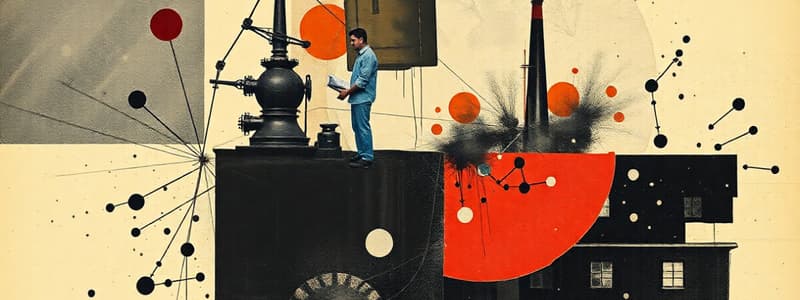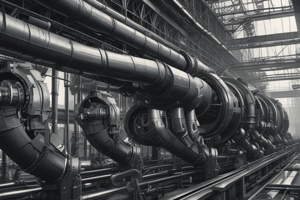Podcast
Questions and Answers
What is the maximum carbon content in steel before it is classified as cast iron?
What is the maximum carbon content in steel before it is classified as cast iron?
- 1.0 percent
- 2.0 percent
- 1.5 percent (correct)
- 2.5 percent
Which structure is the most stable form of iron at room temperature?
Which structure is the most stable form of iron at room temperature?
- Cementite
- Austenite
- Martensite
- Ferrite (correct)
What is the carbon content in Cementite?
What is the carbon content in Cementite?
- 6.67 percent (correct)
- 1.5 percent
- 0.83 percent
- 2.04 percent
What type of structure does Pearlite have?
What type of structure does Pearlite have?
Which alloying element is known to increase the hardness and melting temperature of steel?
Which alloying element is known to increase the hardness and melting temperature of steel?
What is the primary characteristic of Martensite compared to Ferrite?
What is the primary characteristic of Martensite compared to Ferrite?
Which element is added to high-speed steel to interfere with the formation of Cementite?
Which element is added to high-speed steel to interfere with the formation of Cementite?
Which of the following elements must be removed during steel processing to prevent increased brittleness?
Which of the following elements must be removed during steel processing to prevent increased brittleness?
Steel is defined as an alloy of iron, nickel, and carbon.
Steel is defined as an alloy of iron, nickel, and carbon.
Ferrite can dissolve more than 0.021 wt% of carbon at 910 °C.
Ferrite can dissolve more than 0.021 wt% of carbon at 910 °C.
Austenite has a face-centered cubic structure and can dissolve up to 2.04 wt% carbon.
Austenite has a face-centered cubic structure and can dissolve up to 2.04 wt% carbon.
Cementite is a soft and ductile phase of iron-carbon alloy.
Cementite is a soft and ductile phase of iron-carbon alloy.
Pearlite is formed from mixtures of ferrite and cementite layers.
Pearlite is formed from mixtures of ferrite and cementite layers.
Martensite has lower strength compared to ferrite and is thermally stable.
Martensite has lower strength compared to ferrite and is thermally stable.
Nickel and manganese are added to steel to decrease tensile strength.
Nickel and manganese are added to steel to decrease tensile strength.
Stainless steel typically contains 18% chromium and 8% nickel to assist in corrosion resistance.
Stainless steel typically contains 18% chromium and 8% nickel to assist in corrosion resistance.
Vanadium reduces hardness and increases susceptibility to metal fatigue in steel.
Vanadium reduces hardness and increases susceptibility to metal fatigue in steel.
The addition of sulfur and phosphorus makes steel more ductile.
The addition of sulfur and phosphorus makes steel more ductile.
Flashcards are hidden until you start studying
Study Notes
Steel Composition
- Steel is an alloy composed of iron and carbon, with up to 1.5% carbon by weight
- Alloys with higher carbon content are classified as cast iron
- Other elements are added to steel for specific properties
Iron Allotropes
- Ferrite (α-iron) is the most stable form of iron at room temperature, with a body-centered cubic structure.
- It’s a soft and ductile material.
- It can only dissolve a small amount of carbon, up to 0.021 wt% at 910 °C.
- Austenite (γ-iron) has a face-centered cubic structure.
- It’s also soft and metallic.
- It can dissolve a larger amount of carbon, up to 2.04 wt% at 1146 °C.
- Cementite (Fe3C) is a stoichiometric phase with high hardness and low ductility.
- It forms in areas with a higher carbon concentration.
Steel Structures and Properties
- Pearlite is composed of alternating layers of ferrite and cementite, with a total carbon content of 0.83%.
- Pearlite properties vary depending on the carbon content, with a higher carbon content resulting in a mixture of pearlite and cementite grains.
- Bainite is a similar structure to pearlite, but with a different cementite morphology.
- Martensite is a chemically metastable phase with a strength up to five times higher than ferrite.
- It has a similar unit cell structure to austenite.
- Stainless Steel is composed of large amounts of chromium and nickel (around 18% and 8%, respectively).
- These elements form a hard oxide on the metal surface to inhibit corrosion.
- High-Speed Steel contains tungsten which interferes with cementite formation, allowing martensite to form at slower quench rates.
- This results in high-speed steel properties.
- Brittle Elements:
- Sulfur, nitrogen, and phosphorus increase steel brittleness, therefore requiring removal during ore processing.
Steel Properties and Alloying Elements
- Nickel & Manganese: Increase tensile strength and enhance austenite stability
- Chromium: Enhances hardness and melting temperature
- Vanadium: Boosts hardness while reducing metal fatigue
Steel Composition
- Steel is an alloy of iron and carbon, with up to 1.5% carbon by weight.
- Higher carbon content alloys are called cast iron.
Iron Allotropes
- Ferrite (α-iron) is the most stable form of iron at room temperature.
- Body-centered cubic structure.
- Soft and ductile.
- Dissolves only a small amount of carbon (0.021 wt% at 910 °C).
- Austenite (γ-iron) is a face-centered cubic structure.
- Soft and ductile.
- Dissolves significantly more carbon (2.04 wt% at 1146 °C).
Cementite (Fe3C)
- Stoichiometric phase.
- Non-ductile and very hard.
- Forms in regions of higher carbon content.
Pearlite and Bainite
- Laminar structure of alternating ferrite and cementite layers.
- Carbon content: 0.83% by weight.
- < 0.83% Carbon: Mixture of ferrite and pearlite grains.
-
0.83% Carbon: Mixture of pearlite and cementite grains.
- = 0.83% Carbon: Wholly pearlite composition (eutectoid structure).
Martensite
- Chemically metastable.
- Four to five times stronger than ferrite.
- Similar unit cell structure to austenite, but with identical chemical composition.
Steel Alloying Elements
- Nickel and manganese increase tensile strength and stabilize austenite.
- Chromium increases hardness and melting temperature.
- Vanadium increases hardness and reduces metal fatigue.
Stainless Steel
- Contains high amounts of chromium (18%) and nickel (8%).
- Forms a hard oxide layer on the surface to inhibit corrosion.
High Speed Steel
- Tungsten interferes with cementite formation, allowing martensite to form with slower quench rates.
- Results in high-speed steel.
Brittle Elements
- Sulfur, nitrogen, and phosphorus make steel brittle.
- Must be removed from ore during processing.
Studying That Suits You
Use AI to generate personalized quizzes and flashcards to suit your learning preferences.




